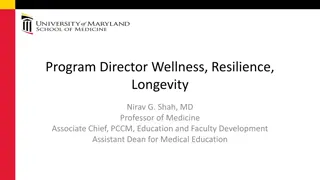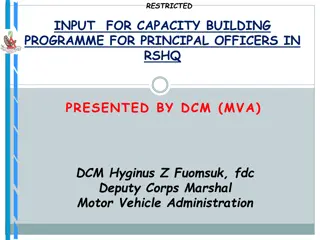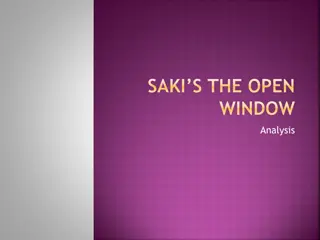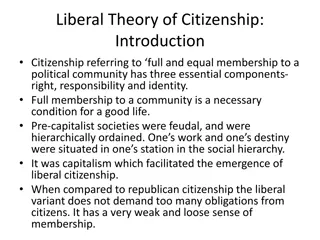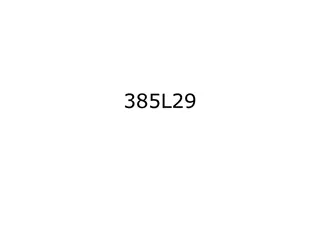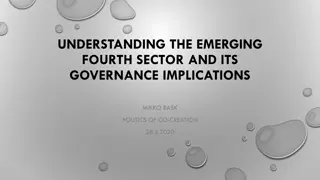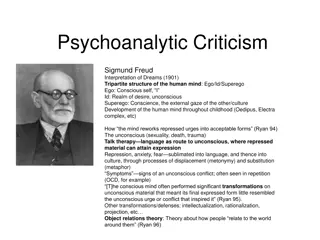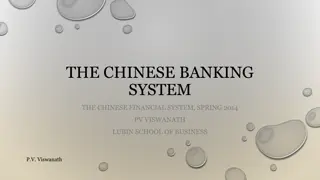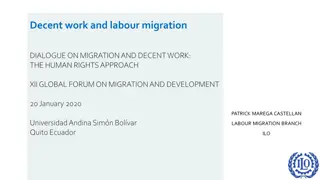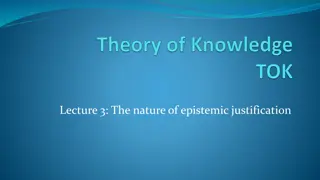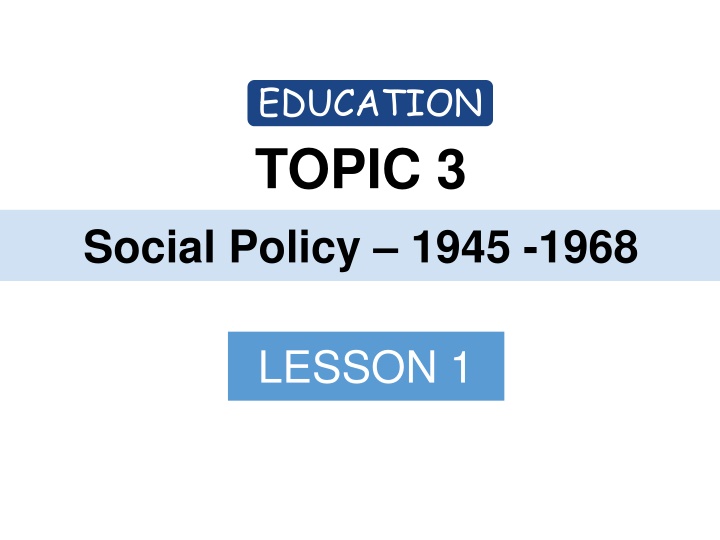
Educational Policy Evolution from 1945 to 1968: A Historical Overview
Explore the evolution of educational policies from 1945 to 1968, focusing on social policy impacts, including the Tripartite system, 11+, Grammar schools, and more. Understand the link between educational policy and inequality while delving into the 1944 Education Act and its effects on workforce education. Discover how class backgrounds shaped educational opportunities and outcomes during this transformative period.
Download Presentation

Please find below an Image/Link to download the presentation.
The content on the website is provided AS IS for your information and personal use only. It may not be sold, licensed, or shared on other websites without obtaining consent from the author. If you encounter any issues during the download, it is possible that the publisher has removed the file from their server.
You are allowed to download the files provided on this website for personal or commercial use, subject to the condition that they are used lawfully. All files are the property of their respective owners.
The content on the website is provided AS IS for your information and personal use only. It may not be sold, licensed, or shared on other websites without obtaining consent from the author.
E N D
Presentation Transcript
EDUCATION TOPIC 3 Social Policy 1945 -1968 LESSON 1
CSWK: Admissions and selection EDUCATIONAL POLICY AND INEQUALITY Do Now/Interleaved Learning: Define : - Tripartite, 11+, Grammar, Secondary modern, Technical schools S&C: Can you link to inequality? SS&C: What is SELECTIVE SCHOOLING? 7 SELECTIVE SCHOOLING: Selection by Ability. Selection by Aptitude. Selection by Faith. LESSON OUTCOMES: SOME A*/A: to evaluate the effectiveness and impact of educational policies on inequality of achievement. MOST B+/B: to explain sociological perspectives on educational policies and impact. ALL: C/D/E: to describe the main features of important educational policies and impact of these.
What were the Educational policy before 1988? Industrialisation increased the need for an educated workforce. In the 19th century the state became more involved in education. The type of education received depended upon class background. Education rarely changed pupils ascribed status. Middle class curriculum prepared them for office work. Working class basic literacy and numeracy skills needed for routine factory work. It also taught them obedience. 1944 Education Act (Butler) The 1944 Education Act created three types of state-funded secondary school Aimed to give every pupil an equal chance to develop their abilities to the full within a free system of education. The major changes were in the secondary sector. At the age of 11, all students took the 11+ exam (IQ test) which determined which one of the following schools you attended: The Act organised the structure of education in England and Wales into three stages (Tripartite System): Grammar schools for those children who passed (around 20%) Primary - 5 to 11. Secondary modern schools for the 75-80% who failed the 11+. Provided a basic education. Secondary - 11 to 15. Technical education for about 5% of the school population. schools provided vocational Further/higher education.
1. What were the Educational policy before 1988? I_____________ increased the need for an ______________d workforce. In the 19th century the st__________ became more involved in education. The type of education received depended upon _________s background. Education rarely changed pupils a__________ status. Middle class c_________ prepared them for o______e work. Working class basic literacy and ___________y skills needed for routine factory work. It also taught them ob____________. 1944 Education Act (Butler) The 1944 Education Act created t________ types of state-f______ secondary schools The ______r changes were in the _________ sector. The 1944 ___________ Act aimed to give e___________ pupil an equal chance to d_________ their abilities to the full within a f_____ system of education. At the age of 11, all students took the ______ exam (IQ test) which d___________ which one of the following schools you a___________: the TASK 1: fill in the missing words The structure of education in England and ________s into (T__________ System): Act o____________d Grammar schools p_________ (around 20%) for those children who three stages Secondary modern schools for the 75-80% who f________ the _____. Provided a b______c education. Primary - 5 to 11. Secondary - 11 to 15. Technical schools provided v_________ education for about______% of the school ____________n. Further/higher education.
2. What were the Educational policy before 1988? Industrialisation i__________ the need for an educated w___________. In the 19th ____________ the s__________ became more i____________ in education. The type of education received depended upon class b__________. Education rarely changed pupils ascribed s_________. __________ class curriculum prepared them for office work. Working class b________ l__________ and numeracy skills needed for routine f________ work. It also t_________ them obedience. 1944 Education Act (Butler) The 1944 Education Act created three t_________ of st_____-funded secondary schools The 1944 Education Act a______d to give every ________ an equal chance to a___________s to the full within a free system of e____________. The major _______s were in the secondary s___________. develop their At the age of ____, all ___________s took the 11+ exam (____ test) which d____________ which one of the following s________ you attended: The s____________e of education in England and Wales into t______ stages (Tripartite System): A___ organised the Grammar ________ for those c____________ who passed (around 20%) ___________ __________ schools for the 75- 80% who failed the 11+. ________ a basic ___________n. Primary - 5 to 11. Secondary - 11 to 15. ___________ schools p___________ vocational education for about 5% of the _______l population. Further/higher education.
3. What were the Educational policy before 1988? ______________n increased the ________ for an educated __________. In the 19th century the state became m__________ involved in education. The t______ of education received _________d upon c________ background. Education rarely c_________ pupils a___________ status. Middle class curriculum prepared them for o__________ work. _________ class basic literacy and numeracy skills needed for r____________ factory work. It also taught them ___________e. 1944 Education Act (Butler) The 1944 Education _____ c________ three types of ______e-funded secondary schools The 1944 Education ____ aimed to give ______ pupil an ______ chance to develop their abilities to the full within a free ______m of education. The major changes were in the ___________ sector. At the ____e of ______, all students took the 11+ _______ (IQ test) which determined which ____ of the following ________ you _________d: The structure of ___________n in England and Wales into three stages (Tripartite System): Act _________d the Grammar schools _______d (around 20%) for those children who Secondary modern schools for the ___-80% who ________d the 11+. Provided a _____c education. ____________y - 5 to 11. Secondary - 11 to 15. Technical ________ education for about 5% of the _________ population. schools provided v Further/_________education.
What were the Educational policy before 1988? Industrialisation increased the need for an educated workforce. In the 19th century the state became more involved in education. The type of education received depended upon class background. Education rarely changed pupils ascribed status. Middle class curriculum prepared them for office work. Working class basic literacy and numeracy skills needed for routine factory work. It also taught them obedience. 1944 Education Act (Butler) The 1944 Education Act created three types of state-funded secondary school Aimed to give every pupil an equal chance to develop their abilities to the full within a free system of education. The major changes were in the secondary sector. At the age of 11, all students took the 11+ exam (IQ test) which determined which one of the following schools you attended: The Act organised the structure of education in England and Wales into three stages (Tripartite System): Grammar schools for those children who passed (around 20%) Primary - 5 to 11. Secondary modern schools for the 75-80% who failed the 11+. Provided a basic education. Secondary - 11 to 15. Technical education for about 5% of the school population. schools provided vocational Further/higher education.
Grammar Schools Secondary Modern Technical schools
TASK 2: HAVE A GO Answer the 11+ questions. Get into small groups. Have a go at some of the questions. 15 THINK about how an 11 year old would feel doing this exam. S&C: What did you think? Was it Hard? Easy? What were the questions like? SS&C: Can you identify any problems with this system? List some criticism for the 1944 Education Act (Butler)/tripartite system, 11+ Sentences starter The 11+ was
CRITICISMS. The 11 Plus was unreliable, the use of IQ testing was not a good measure of academic ability. The 11-plus was accused of having a significant cultural bias. In early papers. "General reasoning" questions could be about classical composers, or the functions performed by domestic servants subjects which children from working class backgrounds would be less able to answer. The selection process: This was unfair and it denied many pupils the opportunity of continuing their education beyond 15. No parity of esteem : Secondary modern schools were seen as second best by parents, pupils and employers. Social Class Divisions: The class divide remained in the education system.
MINI PLENARY spot the trend! 1880 compulsory education for those aged 5-10. Elementary Education Act 1893 compulsory education for those aged 5- 11 and the right to education was extended to deaf and blind children. 1899 - the leaving age was increased again to 13. The Fisher Education Act 1918 - made education compulsory up until 14 years old. 1973 this then rose to16. The Education and Skills Act 2008 increased the minimum age at which young people in England can leave learning. This requires them to continue in education or training to the age of 17 from 2013 and to 18 from 2015.
How can this system be Evaluated? CLASS/ GENDER INEQUALITY 11+ AS A MARKER OF ABILITY MERITOCRACY Consider these three areas to suggest how the tripartite system has merit. Consider these three areas to suggest how the tripartite system can be criticised.
TASK 3: Comprehensive School System In order to overcome the inequality caused by the tripartite system, the comprehensive system was introduced in many areas from 1965 onwards, and aimed to make education more meritocratic. Comprehensive education abolished both selection at 11 by the 11+ exam and the three types of secondary school. It was left to the local education authority (LEA) to decide whether to go comprehensive and not all did so. As a result, the grammar-secondary modern divide still exists in some areas. For example, Lincolnshire still has a high proportion of schools which remain selective grammar schools. Most children now, regardless of their ability, generally transfer to a secondary school at the age of 11 with no selection by exam. Most young people in the UK in 2012 were attending some form of comprehensive school, with only 164 state grammar schools remaining in the UK some of these being in Calderdale. Fully comprehensive schools have no selection by ability at all, and children of all abilities are admitted to the same type of school and taught in mixed ability classes.
TASK 4: Application to theory 1. Create a table and list the advantages/disadvantages of comprehensive schooling. Look back to how Functionalists and Marxists view education. MARXISTS Education served the interests of the capitalists. It reproduces class inequalities. FUNCTIONALISTS Education fulfils essential functions such as social integration and meritocratic selection for future work roles. 2. How would these theorists evaluate the comprehensive school system?
CONSOLIDATION QUESTIONs 3. In what way did the tripartite system reproduce class inequality? 4. Identify 2 reasons why the comprehensive system did not end educational inequality. A LEVEL QUESTION 5. Outline 2 criticisms of the comprehensive school system. (4 marks)
PLENARY: True or false The comprehensive system was introduced in 1944. Technical schools are a part of the tripartite system. Marxists feel that the comprehensive school system prevents class inequalities. Some social policies exist to control education.
HOMEWORK Complete your timeline up to 2010 Use the text book for help

